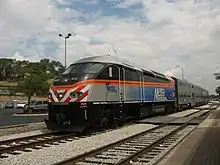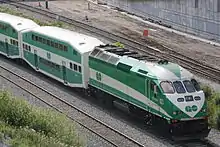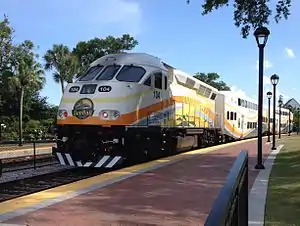MPI MPXpress
The MPI MPXpress is a line of diesel-electric locomotives built by MotivePower (a subsidiary of Wabtec) for commuter rail service. There are five MPXpress models: MP36PH-3S, MP36PH-3C, MP40PH-3C, MP32PH-Q, and MP54AC. Of these, only the MP54AC conforms to federal Tier 4 emissions standards, making it the only model that can be sold in the United States.
| MPI MPXpress | |||||||||||||||||||||||||||
|---|---|---|---|---|---|---|---|---|---|---|---|---|---|---|---|---|---|---|---|---|---|---|---|---|---|---|---|
 New Mexico Rail Runner MP36PH-3C in New Mexico | |||||||||||||||||||||||||||
| |||||||||||||||||||||||||||
| |||||||||||||||||||||||||||
| |||||||||||||||||||||||||||
| |||||||||||||||||||||||||||
The MPXpress line had the first production passenger locomotive that met FRA safety regulations regarding crashworthiness and fire safety. The models in the line also meet APTA crashworthiness standards.
The MPXpress line has also kept pace with increasingly stringent EPA locomotive emissions regulations, having provided the first—and in some cases, only—passenger locomotive for each of the four emission levels (tiers) that were specified by the EPA between 2002 and 2015.
The MPXpress is used by numerous public transit agencies in Canada and the United States; of them, GO Transit has the most, with 93 in their fleet.
As of 2023, Wabtec no longer lists the MPXpress in its locomotive portfolio.[2]
Models
MP36PH-3S

The MP36PH-3S uses a 16-cylinder EMD 645F3B diesel engine as its prime mover, capable of generating 3,600 hp. Head-end power (HEP) is generated by a static inverter that receives its power through connections to the prime mover (hence the "S" (static) designation). Compared to a locomotive with a separate HEP generator, the prime mover must constantly maintain a higher RPM in order to supply power to the passenger cars. The setup is simpler but leads to higher noise levels and higher fuel consumption.
When providing the maximum 500 kW HEP load, maximum traction power is reduced to 2,930 hp since HEP generation diverts some power from the prime mover.[3]
The MP36PH-3S was the first variety of MPXpress locomotive to be built and the launch customer was Metra, a commuter railroad in the Chicago area. Metra ordered 27 of these locomotives in 2001, which were built and delivered between 2003 and 2004. Fourteen were to replace the railroad's aged F40C fleet, while the rest were for fleet expansion. Until 2021, when the 3S variants were converted to 3C's, Metra was the only remaining operator of the MP36PH-3S variant of the MPXpress.
When the locomotives were first delivered, the onboard computer systems proved problematic. At one point in 2004, because Metra had so many MPXpress locomotives out of service, two F40Cs had to be placed back into service for a short time.
Conversion to MP36PH-3C specification
Starting in 2015, Metra began converting its MP36PH-3S locomotives to the MP36PH-3C specification by removing the static inverter and replacing it with a separate HEP generator. Metra's MP36PH-3C locomotives all have extended radiators to supply the extra cooling for the new Caterpillar generators. Locomotive No. 417 was the first one to be converted and was sent to MPI in Boise. The rest were rebuilt at Metra's 47th Street shops on the South Side of Chicago. As of 2021, all of the MP36PH-3S locomotives have been converted to the MP36PH-3C specification.
MP36PH-3C

The MP36PH-3C has the same EMD 645F3B prime mover as the MP36PH-3S model, but with a separate head-end power generator, a Caterpillar C-27.[4]
The launch customer for the MP36PH-3C was Caltrain, a commuter railroad in the San Francisco Bay Area. Caltrain ordered 6 of these locomotives in 2003, which were built and delivered that same year. This locomotive has gone on to become the most popular MPXpress variant, with 100 delivered to nine different customers.
MP40PH-3C

The MP40PH-3C introduced a new prime mover, the larger 16-cylinder EMD 710G3B series diesel engine, capable of generating 4,000 hp. The MP40PH-3C also uses an EMD alternator and traction motors.
The launch customer for the MP40PH-3C was GO Transit, a commuter railroad in the Toronto area. The MP40PH-3C was developed in response to a bid request from GO Transit for locomotives capable of generating 4,000 hp, hauling 12 passenger cars and traveling at speeds up to 93 mph (150 km/h). MotivePower and GE Transportation responded to the request, with MotivePower being selected as the winning bidder. GO Transit placed an order for 27 locomotives in 2006, which were built and delivered between 2007 and 2008.
In 2011, MotivePower upgraded the MP40PH-3C to comply with the EPA's more stringent Tier 3 emissions standard,[5][6] which was in effect between 2012 and 2014. Three locomotives meeting this standard were built, all delivered to Sounder commuter rail in the Seattle area. Ten additional locomotives for GO Transit are also Tier 3 compliant.
MP32PH-Q

The MP32PH-Q was built from 2013 to 2014 for SunRail. They have similar specifications as new MPXpress locomotives, but are rebuilt and refurbished from units that had previously operated on MARC as GP40WH-2 locomotives. Inside the locomotive, the 3,000 hp EMD 16-645E3C prime mover has been rebuilt and electronics have been upgraded using the same equipment as other MPXpress locomotives, as well as a horsepower upgrade from 3,000 to 3,600. On the exterior, the MP32PH-Q retains the hood unit layout of the former GP40WH-2, but a new four-window MPXpress cab replaces the original cab.[5][7]
MP54AC
.jpg.webp)
The MP54AC (also known as MP40PHTC-T4AC)[8] is the latest locomotive in the MPXpress family and the only model available for sale in the US. It is designed to both meet the EPA's stringent Tier 4 emissions standard and offer higher performance than the MP40PH-3C. The MP54AC is a genset locomotive, using a pair of Cummins QSK60 60-liter, 16-cylinder engines rated at 2,700 hp each (5,400 hp total) and during periods of low power demand, the locomotive can operate on just one engine to reduce noise pollution and boost fuel efficiency. The 5,400 total horsepower qualifies the MP54AC as the most powerful diesel-electric passenger locomotive in North America, both currently and historically.
Currently, the MP54AC can be built as new or by having existing MPXpress locomotives rebuilt to the standard.[9]
GO Transit was the launch customer for the MP54AC. The first prototype unit was built by converting a MP40PH-3C owned by GO Transit (unit 647). MotivePower removed the EMD prime mover and HEP motor and replaced them with the twin Cummins engines. Heavy modifications were made to the body to accommodate extra air intake and exhaust stacks.[10][11] Unit 647 was delivered to GO Transit late 2015 and was seen under testing on December 12, 2015.[12]
Initially GO Transit had planned to convert a total of ten MP40PH-3Cs to the new MP54AC standard; it later ordered 16 additional newly built MP54AC locomotives[13] and eventually converted the order for rebuilt units to new builds for a total of 26.[14]
The MP54AC competes with other Tier 4 compliant locomotives, such as the Siemens Charger series and the EMD F125. Both the MP54AC and F125 have struggled to find customers, unlike the Charger series, which has sold more than 350 units including large orders from Amtrak and Via Rail.[15][16]
Operators
| Railroad | Qty. | Road Numbers | Notes |
|---|---|---|---|
| MP36PH-3S | |||
| Metra | 27 | 401–427 | Converted to MP36PH-3C standards |
| MP36PH-3C | |||
| Caltrain | 6 | 923–928 | |
| FrontRunner | 18 | 1–21 | Unit 12 sold to Northstar Commuter Rail; units 13 & 14 sold to MBTA |
| MARC | 26 | 10–35 | |
| MBTA | 2 | 010–011 | Bought from FrontRunner as units 13–14 |
| Metrolink | 15 | 888–902 | |
| New Mexico Rail Runner Express | 9 | 101–109 | |
| Northstar Line | 6 | 501–505, 512 | Unit 512 bought from FrontRunner as unit 12 |
| Virginia Railway Express | 20 | V50–V69 | |
| West Coast Express | 1 | 906 | |
| MP40PH-3C | |||
| Sounder | 3 | 921–923 | Upgraded to Tier 3 standards |
| GO Transit | 67 | 600-646, 648-666 | One converted to an MP54AC |
| MP32PH-Q | |||
| SunRail | 11 | 100–110 | Rebuilt from MARC GP40WH-2s |
| MP54AC | |||
| GO Transit | 26 | 647, 667-682 | One converted from MP40PH-3C |
Internal layout

References
- "LOS ANGELES COUNTY METROPOLITAN TRANSPORTATION AUTHORITY: Diesel Multiple Unit (DMU) Technical Feasibility Analysis" (PDF). LTK Engineering Services. May 4, 2009. Retrieved September 7, 2014.
- "Locomotive Equipment". Wabtec. Retrieved 2023-04-17.
- "Locomotives". LTK Engineering Services. Archived from the original on March 4, 2016.
- Lex, Robert (29 September 2013). "Northstar Commuter Rail MP36PH-3C Parts". Parts List for MPXpress Locomotives.
- "SunRail, Sound Transit order MotivePower locomotives". Trains. September 12, 2011. Archived from the original on September 20, 2012. Retrieved September 13, 2011.
- "Archived copy" (PDF). Archived from the original (PDF) on April 15, 2012. Retrieved November 3, 2011.
{{cite web}}: CS1 maint: archived copy as title (link) - Murdock, Ken (April 2014). "Winter Park's Station Dedication" (PDF). The Flatwheel. 3–5. Archived from the original (PDF) on September 8, 2014.
- "MotivePower Tier 4 diesel delivered to Go Transit". International Railway Journal. 16 March 2018. Retrieved 16 March 2018.
- "MP54 AC Commuter Locomotive | Wabtec Corporation". www.wabtec.com. Retrieved 2016-11-28.
- "MP54 AC COMMUTER LOCOMOTIVE". Wabtec Corporation. Retrieved 2015-12-16.
- "MP54AC" (PDF). Wabtec. Archived from the original (PDF) on December 17, 2015.
- "First MP54AC testing on GO Transit". Railway Age. 14 December 2015. Retrieved 2015-12-16.
- "Prototype MP54AC delivered to Metrolinx, GO Transit". Railway Age. 2 March 2016. Retrieved 16 March 2018.
- "GO's MPI Series (MP40PH-3C and MP54AC) Locomotives (2007- ) - Transit Toronto - Content".
- "Amtrak to Improve National Network with New Locomotives" (Press release). Amtrak. December 21, 2018. Archived from the original on January 26, 2021. Retrieved October 19, 2020.
- "Siemens Canada secures major order with VIA Rail Canada for new fleet of passenger trains" (Press release). Siemens Mobility. December 12, 2018.